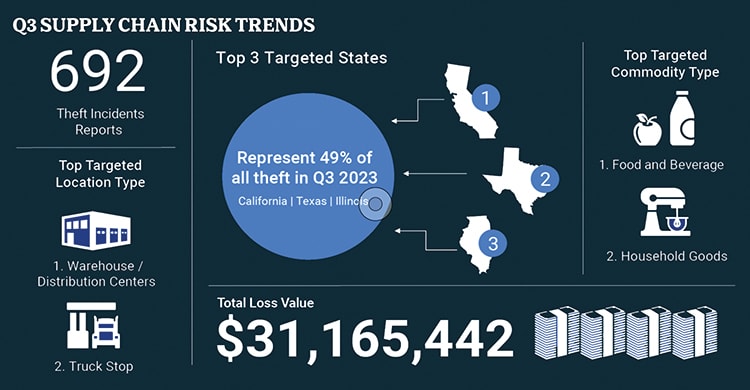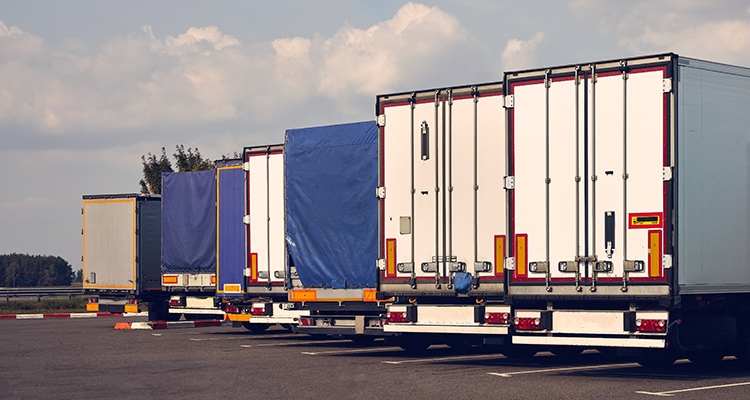To Catch a Thief: 5 Ways to Boost Cargo Security

With cargo thefts surging, bolstered by sophisticated new tech-based methods, it has never been more important for shippers and their partners to emphasize security best practices.
Cargo theft is on the rise, and thieves are becoming savvier and more sophisticated. They use a variety of technologically based tools to steal goods and materials in fresh ways—and to create new challenges for supply chain and logistics managers.
CargoNet recorded 692 cargo thefts in the third quarter of 2023, a 59% increase when compared to the same period in 2022. Still, even with cargo thefts surging, the supply chain field as a whole largely does a good job of preventing theft, says Keith Lewis, vice president of operations for CargoNet at Verisk.
The problem is “that when things go wrong, they go very wrong, and it has a significant impact,” he adds. The chief challenge for companies is taking the necessary steps to prevent theft without slowing the movement of freight significantly and undermining their profits.
Here are some key ways that shippers and others can work to combat cargo theft in the most challenging landscape in years.
1. Understand the new vulnerabilities.
Cargo theft can be divided into two types: straight theft and strategic theft, according to Scott Cornell, transportation segment lead, crime and theft specialist at Travelers.
Straight theft, the most common and traditional form, means physically stealing cargo. Strategic theft is less straightforward and it’s rapidly on the rise, jumping a startling 430% year-over-year in the third quarter of 2023.
“Strategic theft is when thieves use methods such as identity theft, fictitious pickups, and double brokering scams,” Cornell explains. “That’s done partially virtually.
“We’ve seen the largest increases in that category since about halfway through 2022, all through 2023, and we expect it to continue into 2024,” he adds.
Thieves essentially find ways to exploit the systems that have been implemented to make the supply chain faster and more efficient.
“Whether that’s load boards, the use of email, or internet platforms—all those things that have been put in place to help the supply chain move as quickly as demand—are the same things that cargo thieves take advantage of,” Cornell says.
The pressure to move freight faster to keep up with customer expectations can create “an environment where things fall through the cracks,” Cornell says.
“Moving freight at the speed of light, even if we are do a very good job of vetting, creates vulnerability,” Lewis says.
While busy port areas remain the most-targeted areas for thieves, the use of identity theft and other virtual methods means that thieves can steal cargo anywhere, widening the geography of where thefts are occurring to the interior of the United States and other nontraditional cargo theft areas.
“That will be a big shift for the industry going forward,” Cornell says. “How do you deal with that, when most of the resources that have been built over decades around cargo theft are concentrated in those traditional hotspot areas?”
2. Put in place processes, procedures, and culture.
Companies should have strong processes and procedures in place to prevent theft, and maintain diligent training and oversight of those processes to ensure team members do not cut corners.
Cargo theft is often about people failing to follow basic protocols. “Many cargo thefts, especially pilferages, are crimes of opportunity,” notes J.J. Coughlin, chairman of the Southwest Transportation Security Council.
Security needs to be treated as a company-wide point of emphasis—a focus integral to an organization’s culture and to its relationship with its partners and providers. “Everyone should be pulling the rope in the same direction and understanding what you’re trying to do and how you’re trying to do it,” Coughlin says.
Cornell agrees that solid processes and procedures serve as the foundation for cargo theft prevention. For instance, he points to the value of using a “red zone.”
“Cargo thieves will sit in surveillance outside a distribution center and follow loaded trucks as they come out,” Cornell says. “They hope that the driver goes straight to a truck stop to fuel and have a meal before they get back on the road. That gives them an opportunity to steal the tractor and trailer.
“A red zone is about making sure drivers are fueled and rested prior to picking up the freight, so that when they pick up a load, they can travel 200 to 250 miles without making a stop,” he says.
“That won’t eliminate the opportunity for cargo thieves to follow them, but more often than not thieves are looking for the truck that will go 20 to 30 miles,” Cornell says. “You improve your odds.”
As part of their procedures, shippers need to have a firm plan in place in the event of a theft. That includes knowing what resources to access and who to contact immediately for support to work toward recovering the stolen cargo.
“If a theft occurs at 2 a.m. Friday, everybody needs to know what their role is, and they need to be able to execute it quickly because after the first 24 to 48 hours, the chances of recovery drop by 50%,” Cornell says.
3. Leverage tools, data, and intelligence

Tactically, locks and plastic seals are a vital part of securing loads. The simple use of locks—such as high-security rear locks, landing gear locks, air cuff locks and kingpin locks—can have a consequential impact on combating theft.
“Anything you can do to deter a thief for a bit makes it more likely they will go somewhere else,” Lewis says.
Technology also offers an array of ways to help curb cargo theft. That includes visibility tools and GPS-based covert tracking, which can be integrated into the trailer or into the cargo itself.
Technology also can provide alerts when doors have been opened or when a truck is moving when it is not supposed to be.
Carriers, drivers, and others also should be aware of trends in cargo theft so that they are aware of areas where cargo often is stolen and how it’s stolen so that they can avoid possible vulnerabilities.
For instance, CargoNet provides data and intelligence about theft that companies can use to improve security, including noting routes and stops that have proven to be problem areas. If CargoNet puts out Be On the Lookout (BOLO) notices about cargo thefts into a particular area, then carriers and others should be aware of that threat and take precautions accordingly.
“It’s important for companies to ask if they’re getting the right information to their decision-makers so that they can act accordingly,” Lewis says.
4. Vet and verify.
Identity theft is common in the consumer world, but it is also a common method of strategic theft. The best way to prevent it is by vetting carriers thoroughly.
Thieves will steal the identity of a legitimate trucking company then go to a load board and solicit a load that appeals to them.
“In that scenario, freight brokers have to be good at vetting that carrier and realizing that it is not actually ABC Trucking, even though it’s pretending to be,” Cornell says.
That means learning to spot the red flags that indicate identity theft has taken place and putting in place measures that prevent thieves from accessing the screening process in the first place.
In the case of a so-called fictitious pickup, a freight broker may have done everything correctly, including properly vetting a legitimate carrier. However, cargo thieves will show up ahead of the scheduled pickup, pretend to be the appropriate carrier, and then be allowed to take the cargo erroneously.
“It is important for there to be open lines of communication and good processes and procedures in place with that shipper to verify that the carrier and driver that they say is there to pick up the load is the carrier who that load is supposed to be released and assigned to,” Cornell says. “That’s the key to avoiding a fictitious pickup.”
Shippers sometimes assume that the broker they hired has done due diligence on any carrier that they use, but that is not always the case. Instead, shippers should make their security requirements clear to anyone they partner with and ensure that partners are contractually liable if they fail to follow established security procedures.
Shippers who use third-party logistics providers or outsourced transportation services often do not obtain all relevant information from the driver and unit picking up their goods.
“I call this ‘point of pick-up control,’” Coughlin says. “You must capture unit information, license plates, Department of Transportation numbers, markings and pictures on the tractor/trailer, driver license information, and pictures. Then, if the loads go missing, you have something to provide to law enforcement.
“Don’t assume someone has all this information because 90% of the time they don’t,” he cautions.
5. Stay involved.
Getting involved with industry organizations that emphasize cargo security is one way for companies to strengthen their security efforts.
For instance, the Transported Asset Protection Association, a nonprofit organization that develops industry standards for supply chain security, hosts the kind of security-focused webinars, conferences and courses that can be invaluable, Cornell says.
Joining regional security councils such as the Southwest Transportation Security Council also can bring large benefits for organizations as a place to share intelligence and resources.
“Get involved in different organizations so that you can have access to the current intelligence that the industry is providing,” Cornell says. “It’s a great way to be a part of the solution to the cargo theft problem.”
Park It

Parking and safe areas for pit stops are enduring challenges and critical to cargo security.
A lack of available truck parking ranks second on the list of the trucking industry’s top concerns—the highest the issue has ever ranked on the list—finds the American Transportation Research Institute’s 19th annual Top Industry Issues report released in October 2023.
“Secure parking and secure stopping areas are sore spots for drivers,” says J.J. Coughlin, chairman of the Southwest Transportation Security Council. “Truckers work within mandated driving time limitations, and many times they deliver to industrial areas of the city that are not the best parts of town.
“Drivers need to pre-plan their trip and identify where it will be safer to stop, rest, or refresh,” he says.
One resource to help drivers with their search for parking is the Trucker Path app, which provides real-time information from its nearly 1 million driver users at all hours of the day on a variety of driver-related topics, including truck stops and parking availability. Trucker Path also recently partnered with We Realize to allow drivers to use the app to reserve secured parking at certain lots.
“In the past six or seven years, many private parking locations have popped up with reserved parking available, and that’s a viable solution,” notes Chris Oliver, chief marketing officer for Trucker Path. “Truck stops and rest areas are viable as well, but finding them is not always easy. That’s the void that the app looks to fill.”
With parking, it usually is better for drivers to use foresight rather than to improvise, particularly in densely populated areas with highly competitive parking climates where reserving a paid spot might make sense.
“Drivers have a good feel of where they will be at the end of a day or a shift,” Oliver says. “Planning ahead based on that information can be important.”
In addition to finding secure parking spaces, one simple method of reducing thefts in truck parking lots is parking a trailer back-to-back with another trailer, making access to the trailer nearly impossible.
As an alternative, Keith Lewis, vice president of operations for CargoNet at Verisk, recommends that drivers pull straight into parking spots rather than backing into them, ensuring that the trailer doors are exposed and potential thieves do not have cover to access them.
